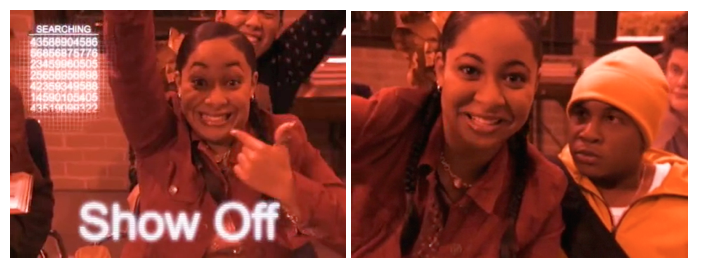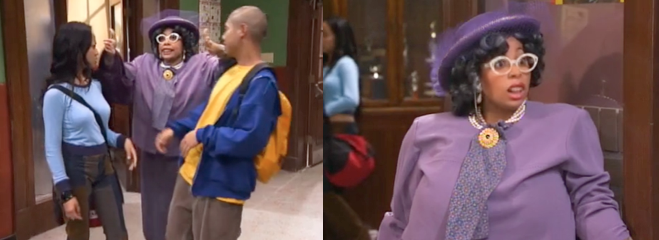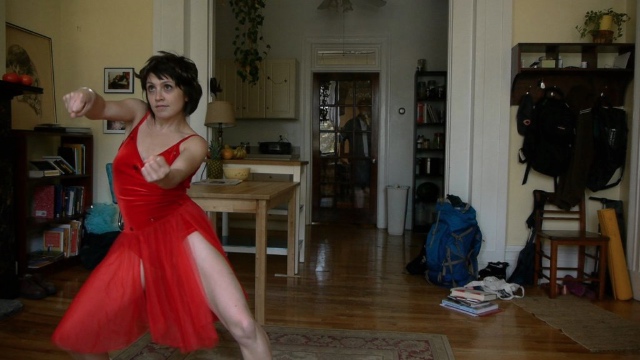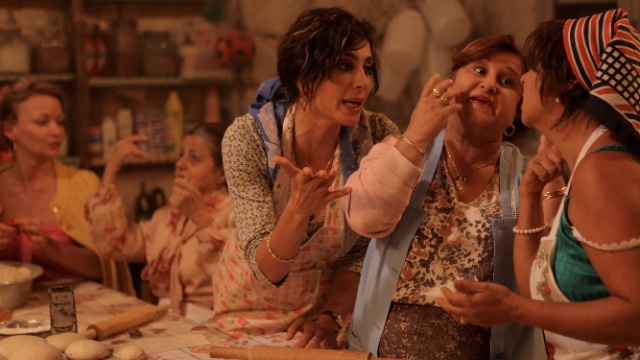
Viewed through a patriarchal lens, (young) women’s bodies are habitually seen as too fragile, too precious, to slip on a banana peel or fall down a flight of stairs. — Alex Clayton, The Body In Hollywood Slapstick
*
Raven Baxter, the extravagant psychic heroine of Disney’s That’s So Raven (2003-2007)[i], hates being ignored. When she’s cast as the Wicked Witch of the East and not Dorothy in her high school’s production of The Wizard of Oz, she rewrites the role so that it fits her need for attention. When her crush is taking too long to invite her to the spring ball, she performs a variety of dance and gymnastics routines to make him notice her in the hallway. It’s clear that Raven Baxter firmly believes her natural place is under the spotlight, but it’s the captivating performance of the teen actress behind the character, Raven-Symoné, that deserves the credit for convincing audiences that there’s no other place Raven can occupy.
Despite the show’s popularity and the recognition of Raven-Symoné’s comedic gift, it’s surprising that That’s So Raven and its star have not garnered much critical attention from feminists and/or slapstick comedy enthusiasts. A lot has been written about the Disney sitcom, but its success has almost always been measured in terms of numbers: the 100th episode milestone, the record number of viewers, the money made from the merchandising. Is it Raven-Symoné’s race, her gender, her age, the channel on which the show was broadcast—and thus its intended audience, tween girls—that can explain this inattention? It’s most likely some combination of all of the above. But also, because of the transgressive nature of their craft, physical comediennes have been notoriously erased from the canon of slapstick, both dissuaded from entering the space of comedy and excised from its history, and a young comedienne like Raven-Symoné was even more vulnerable to such erasure. Put another way: who takes t(w)een girls seriously?
Put another way: who takes t(w)een girls seriously?
In spite of the highly charged public controversies that surround Raven-Symoné today, the spectacular and dense interpretation she sustained throughout the whole of the series demands going back to explore the depth of her performance. Looking to Kathleen Rowe’s seminal invocation of the unruly woman in comedy (The Unruly Woman: Gender and the Genres of Laughter) and the mobilization of sass within the tradition of slapstick gives a framework to begin to approach Raven as the ingenious physical comedienne she was.
*
Raven-Symoné is first introduced as Raven Baxter in a classroom setting in the 2003 series pilot, “Mother Dearest.” As her teacher, Mr. Petrachelli (Ernie Sabella), interrogates the class, a visual gag on screen shows him “scanning” his students, Terminator-style, to identify his next victim. After skipping over the “Kiss-Up” and before settling on the “Clueless” student as his prey, the scanner turns to a young black girl whose name we don’t yet know, with pigtails, a big smile, and a raised hand: the “Show-Off”. As Mr. Petrachelli ignores her twice, she chases the camera with her face, attempting to draw attention to herself:

“Hey! Just in case you didn’t know my hand is up over here? Alright, just letting you know, alright.”
“Show off” appears to be an honest introductory shot, placing Raven Baxter directly in the pantheon of television’s unruly women who discard propriety and enjoy making a spectacle of themselves. Raven embodies a rare teenage version of this image. She loves the camera and it’s clear that the camera loves her back, capturing all of the agitations in her face via close-ups, framing her outlandish gestures, and recording the spontaneous grunts. Her frighteningly inspired impersonation of the pop star Liz Ania in the episode “If I Only Had a Job” only confirms that Raven is definitely a natural diva. After all, this is her show.
She loves the camera and it’s clear that the camera loves her back, capturing all of the agitations in her face via close-ups, framing her outlandish gestures, and recording the spontaneous grunts.
Given this, it’s hard to imagine that in the pilot, when the show was not yet named That’s So Raven, Raven-Symoné was only playing the sidekick. Though the 15-year-old actress had more than a decade of grinding behind her as a model, occasional rapper, singer and child actress, she inhabited supporting roles, having notably orbited around paternal figures in sitcoms such as The Cosby Show (1984-1992) and Hangin’ With Mr. Cooper (1992-1997) or in film franchises like Dr. Dolittle (1998). A few years before landing the role of Raven Baxter, she played Nebula Wade, Zenon’s charismatic best friend in Zenon: Girl of The 21st Century (1999). Raven-Symoné’s work in the 1990s was evidently enough to cultivate the unique comic persona, charisma, and acting maturity that Raven Baxter came to be known for. And indeed, Raven-Symoné’s audition was so impressive that she revealed herself to be the only choice for the lead, prompting the team to rewrite the show so that her character became the star. That’s So Raven was born.
Formally, the show was a return to the traditional sitcom style, with a multiple-camera setup, a live audience, and the laugh track as it was first introduced by CBS’s I Love Lucy (1951-1957), a show that featured a precursor to Raven Baxter’s larger-than-life style of funny female character with Lucille Ball as Lucy. The show used extra-fictional characteristics (like the actress’s real name as well as her singing career in the last seasons), and served as a vehicle for its main actress’ comedic performance.[ii] There had been funny girls on Disney Channel before Raven, but Hilary Duff’s clumsy Lizzie McGuire (2001-2004) and Christy Carlson Romano’s uptight Ren Stevens in Even Stevens (1999-2001) had nothing of the uninhibitedness and physicality of Raven. While Lizzie McGuire and Even Stevens presented as comedies of manners, That’s So Raven distinguished itself with the reintroduction of a tradition of slapstick comedy that had hitherto been abandoned to cartoons.
The rewriting of the show to focus on Raven subverted the on-screen hierarchies audiences we were used to seeing. The new configuration put a neglected figure in pop culture, the “sassy Black girl”, at the centre of the frame in a rare and audacious gesture, reminiscent of the one Paul Feig employed with Freaks and Geeks (1999-2000) when he moved the titular outcasts from the background to fore. Hypervisible yet under-utilized, the sassy Black girl has been at once exploited for her humour, resourcefulness, and expressivity, for the spice and comic relief she can supply to a show or film, and mocked and denigrated for what mainstream culture has constructed as a deviant behaviour. That’s So Raven broke these rules by boldly embracing the unruliness of “sass”, realizing the potential for situations and storylines that this disposition could offer. It gave the sassy Black girl a family, a home, and a colourful bedroom as well as friends, an obsession with fashion, and a distinctive psychic power.
That’s So Raven broke these rules by boldly embracing the unruliness of “sass”, realizing the potential for situations and storylines that this disposition could offer.
Not since the era of blaxploitation had sassiness been so well used to embody a character. And while some credit goes to Lucille Ball, Raven’s lineage can also be traced back to blaxpolitation classics likes Cleopatra Jones (1973) and Coffy (1973). In these films, Pam Grier immortalized these “sassy, attractive, stylish black heroines with plenty of ’tude”[iii] and paved the way for the bold and brash Baxter. In the womanist cosmogony, sassiness is defined as the way a Black woman makes an impression in the world. Like dandyism, sassiness is a style, an aesthetic, and the formal expression of a confident feminine spirit, manifesting itself through a corporeal attitude and idiolect. It’s these very elements that Raven-Symoné tapped into and particularized to forge her character’s on-screen persona. A native of Atlanta, Raven-Symoné was able to mine and express her southern Blackness, stylizing her elocution and posturing to design the character. The signature elements of her performance, from her larger-than-life facial expressions to catchphrases like, “Girl, please.You be trippin’”, “I’m just sayin’”, and the ever-so-popular “Ya Nasty!” remain immortalized in viral GIFs and memes that still have traction today.
*
“When my hand is up I know the answer. When my hand is down I don’t know the answer.
Let me explain it again: hand up = know, hand down = don’t. I’m just sayin’!”
Each episode follows the same schema: Raven has a vision, and her interpretation of this vision becomes the catalyst for disorder. Raven herself is usually the disruptive element precipitating chaos at school or at home, a “body-catastrophe”[iv]: it’s both experienced by our heroine as a character flaw and a gift that she can use to help others (but mostly serve herself). It’s the combination of Raven Baxter’s power and her impulsive, oftentimes self-centered personality, that leads her to change the outcome of these visions and becomes the source of burlesque situations.
Take the first scene of the pilot, which begins with Raven envisioning herself being lauded for standing up to her teacher. Inspired by this vision, she stands up and calls out Mr. Petrachelli’s perverse habit of calling on people who do not know the answers to his questions. After being told to sit down, Raven continues to talk back until her impertinence leads Mr. Petrachelli to call a parent-teacher interview. How does Raven Baxter deal with the threat of a parent-teacher reunion, especially when her parents have been so proud of her lately for behaving? By dressing up as her mother, of course. Or, more accurately, a grotesque version of her mother. Wearing a purple costume, a grey curly wig, fake teeth and glasses with an exaggerated booty and breasts, Raven performs what she assumes is her teacher’s idea of what a Black mother looks like, while looking nothing like her real mother. The ensuing sequence is the first of many uproarious acts that punctuate and galvanize the series.

As is a hallmark of slapstick and comedian comedy[v], Raven-Symoné’s comic grace is deployed in gags present in each episode. These moments, as the events of the pilot episode continue to illustrate, were entirely devoted to showcasing the inventiveness of Raven-Symoné: an inventiveness that ranged from comic timing, to physical dexterity, to facial expressions, to precise impersonations, to accents and voice modulations. These talents radiated on screen and made watching the show a riveting, energizing experience.
As the pilot rolls on, Raven deploys slapstick in full effect. Still in her “motherly” garb, Raven attempts to sit in a chair and falls in front of her teacher who, after many exhausting interactions with his student, finally decides to go home. She dances in the hallways of her school, hits students with her bag, asserting the authority the costume momentarily affords her.
*
Cory: Okay, body parts: you clip your toenails at the kitchen table.
Raven: I do not!
Cory: You blow your nose and then look in the tissue.
Raven: Okay, that was once…and it was a surprising color.
No blood or real flirtation with death appeared in the slapstick of That’s So Raven, but still the show proposed a world in which a girl could brutally fall from the ceiling of her high school and down the stairs of a movie theater, or ridicule herself in front of boys—and survive both physically and emotionally. In later seasons, Raven’s unruliness was even more pronounced and visible as her body got bigger, giving way to moralizing storylines like in the episode “Food For Thought,” but also to experimentation with the actress’s body which from the beginning was approached as a site of (almost incredulous) possibility.
The legacy of That’s So Raven will be to have shown that a young girl’s body could be animated and plural, in constant metamorphosis and motion occupying highly-regulated spaces such as her school and her home: dressed as a jock, swollen by allergy, blue after a bad chemical experience, transformed into a cow. Raven-Symoné’s performance was, in the context of a tween show, risky and audacious. How is it possible to forget the image of Raven, stuck in her school’s hot air ducts, her face covered in melted cheese and tears?
How is it possible to forget the image of Raven, stuck in her school’s hot air ducts, her face covered in melted cheese and tears?
The show’s writers crafted a character that was both feminine and funny, and especially remarkable where the interaction of the two was concerned. Her excessive femininity, embodied in her outlandish sartorial choices and obsession with fashion, could be the source of satire, but in the vein of Miss Piggy it was always compatible with a certain ingenuity. After all, if she was creating disorder, she was also almost always the one who found ideas to re-establish order.
*
Raven’s lively occupation of the frame with her voice and body, her indocility, and her exuberance were singular, certainly on the Disney Channel but also beyond, especially where her age, femininity, and blackness were considered. Alex Clayton, evoking Merleau-Ponty, describes the slapstick body as “dualistic”, a subject-object “acting within and on the world.”[vi] It is that very duality that patriarchy and anti-blackness refuse to afford to the Black/woman’s body and that’s expressed through both sassiness and slapstick. What is ridiculed in on-screen representations of Black sassiness and stigmatized in women’s slapstick is the physical activity itself—the contortions of the face, the gestures, and the movements that suggest a subjectivity or the presence of a spirit. Sass has been recognized as a defensive posture that enslaved African women would employ to contest the established power relationships and resist total objectification at the risk of punishment in the era of slavery, while contemporary poet and scholar Joanne Braxton has gone on to theorize about the disruptive use of sass by 19th century Black woman writers. As a sassy clown of sorts, Raven was thus doubly disruptive. Funny but also loud, antagonistic, animated, and excessive, she was at odds with the self-contained and understated teenage representations and performances circulating on screen.
Love for this comedienne is largely parallel to a love of action heroines, acrobats and athletes— in fact a comedienne is an action heroine, an athlete, an acrobat. Frantz Fanon’s memorable assessment of the fantasy of the colonized in The Wretched of The Earth becomes pertinent: where Fanon speaks of the colonized person’s fantasy of jumping, swimming, and running, “of action and of aggression[vii],” That’s So Raven’s main character offers the same liberating motif: Raven jumps on tables, dances freely, and talks back with style and grace. That this burlesque comedienne doesn’t teach us anything is a fallacy: her intention might not be pedagogical, but through her movements and relationship to the world around her, she tells us about the oppressive structures governing our bodies and limiting our mobilities, suggesting a way to disrupt them. It might be fitting to say that Raven’s most generous gift is her particular mode of embodiment, an unapologetic and fearless way of being in the world. Above all, she still makes us laugh. So as we reflect on the legacy of physical comedy and its masters, let’s not forget about Raven. She wouldn’t appreciate it.





